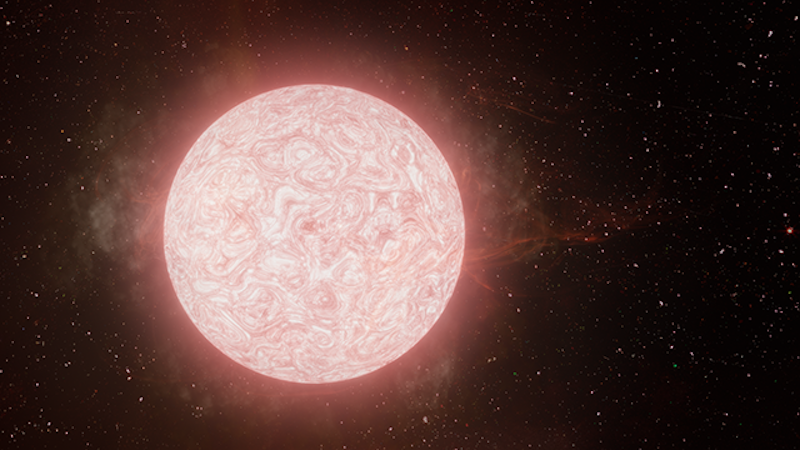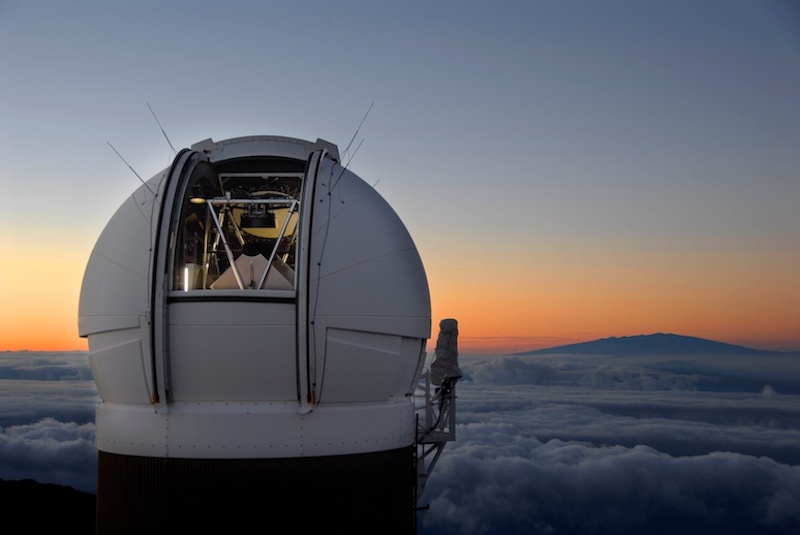Like living things, stars eventually reach the end of their lives. And the most massive stars die by exploding as supernovae. Now, for the first time, astronomers have obtained images of the last moments of a massive red supergiant star, prior to its going supernova. The astronomers caught the the dying star’s explosive end in the course of their research program, called the Young Supernova Experiment. They observed the star during its final 130 days. The giant star is (or rather was) located in galaxy NGC 5731, about 120 million light-years away. These astronomers called their observations “a breakthrough.”
Astronomer Wynn Jacobson-Galán of UC Berkeley, and lead author of the study of this star, said in a statement:
This is a breakthrough in our understanding of what massive stars do moments before they die. Direct detection of pre-supernova activity in a red supergiant star has never been observed before in an ordinary Type II supernova. For the first time, we watched a red supergiant star explode!
Jacobson-Galán and his colleagues used two different observatories in Hawaii, Pan-STARRS and the W. M. Keck Observatory, to acquire their observations. They published their peer-reviewed findings on January 6, 2022, in The Astrophysical Journal.
They said that catching the star’s end was in part just lucky timing.
The 2022 lunar calendars are here. A few left. Order yours before they’re gone!

Witnessing a dying star’s explosive end
Significantly, this is the first time that a spectrum – a rainbow array of starlight, split into its component colors – has been obtained from a supernova as it occurred. The Pan-STAARS telescope obtained the first data on this star in the summer of 2020. By the following fall, the star had gone boom. Luckily, the researchers were able to obtain a spectrum of the explosion, now called supernova 2020tlf, aka SN 2020tlf.
The results showed evidence of dense circumstellar material around the star. This is thought to be the same gaseous material that Pan-STARRS had imaged being violently ejecting some months earlier.
According to senior author Raffaella Margutti at UC Berkeley:
It’s like watching a ticking time bomb. We’ve never confirmed such violent activity in a dying red supergiant star where we see it produce such a luminous emission, then collapse and combust, until now.

New insights into red supergiants’ final moments
The event provides valuable new insight into how supernovae occur, and also some surprises. Previously, scientists thought that red supergiants tended to be fairly quiet just before they exploded. In the case of SN 2020tlf, however, the star was not so quiet. Bright, intense radiation was detected coming from the star in the final year leading up to the supernova.
This is evidence of significant changes in the internal structure of at least some similar stars. The massive ejection of gaseous material then occurs just before the explosion and collapse itself.

Follow the luminous radiation
As you’ve probably heard, the saying “follow the water” is often used regarding the search for life elsewhere. Now, in the case of identifying red supergiants about to explode, the saying might be more more like “follow the luminous radiation.” If the results from these observations can be extrapolated to other red supergiants, then such radiation could be the signal of an impending supernova.
Overall, the findings from SN 2020tlf will provide valuable clues about how giant stars behave in their final moments. Jacobson-Galán said:
I am most excited by all of the new ‘unknowns’ that this discovery has unlocked. Detecting more events like SN 2020tlf will dramatically impact how we define the final months of stellar evolution, uniting observers and theorists in the quest to solve the mystery on how massive stars spend the final moments of their lives.
Bottom line: For the 1st time, a dying star’s explosive end has been caught as it happened. Two telescopes in Hawaii observed the star for its final 130 days, prior to its going supernova.
The post Dying star’s explosive end seen by astronomers first appeared on EarthSky.
from EarthSky https://ift.tt/3GAxu1e
Like living things, stars eventually reach the end of their lives. And the most massive stars die by exploding as supernovae. Now, for the first time, astronomers have obtained images of the last moments of a massive red supergiant star, prior to its going supernova. The astronomers caught the the dying star’s explosive end in the course of their research program, called the Young Supernova Experiment. They observed the star during its final 130 days. The giant star is (or rather was) located in galaxy NGC 5731, about 120 million light-years away. These astronomers called their observations “a breakthrough.”
Astronomer Wynn Jacobson-Galán of UC Berkeley, and lead author of the study of this star, said in a statement:
This is a breakthrough in our understanding of what massive stars do moments before they die. Direct detection of pre-supernova activity in a red supergiant star has never been observed before in an ordinary Type II supernova. For the first time, we watched a red supergiant star explode!
Jacobson-Galán and his colleagues used two different observatories in Hawaii, Pan-STARRS and the W. M. Keck Observatory, to acquire their observations. They published their peer-reviewed findings on January 6, 2022, in The Astrophysical Journal.
They said that catching the star’s end was in part just lucky timing.
The 2022 lunar calendars are here. A few left. Order yours before they’re gone!

Witnessing a dying star’s explosive end
Significantly, this is the first time that a spectrum – a rainbow array of starlight, split into its component colors – has been obtained from a supernova as it occurred. The Pan-STAARS telescope obtained the first data on this star in the summer of 2020. By the following fall, the star had gone boom. Luckily, the researchers were able to obtain a spectrum of the explosion, now called supernova 2020tlf, aka SN 2020tlf.
The results showed evidence of dense circumstellar material around the star. This is thought to be the same gaseous material that Pan-STARRS had imaged being violently ejecting some months earlier.
According to senior author Raffaella Margutti at UC Berkeley:
It’s like watching a ticking time bomb. We’ve never confirmed such violent activity in a dying red supergiant star where we see it produce such a luminous emission, then collapse and combust, until now.

New insights into red supergiants’ final moments
The event provides valuable new insight into how supernovae occur, and also some surprises. Previously, scientists thought that red supergiants tended to be fairly quiet just before they exploded. In the case of SN 2020tlf, however, the star was not so quiet. Bright, intense radiation was detected coming from the star in the final year leading up to the supernova.
This is evidence of significant changes in the internal structure of at least some similar stars. The massive ejection of gaseous material then occurs just before the explosion and collapse itself.

Follow the luminous radiation
As you’ve probably heard, the saying “follow the water” is often used regarding the search for life elsewhere. Now, in the case of identifying red supergiants about to explode, the saying might be more more like “follow the luminous radiation.” If the results from these observations can be extrapolated to other red supergiants, then such radiation could be the signal of an impending supernova.
Overall, the findings from SN 2020tlf will provide valuable clues about how giant stars behave in their final moments. Jacobson-Galán said:
I am most excited by all of the new ‘unknowns’ that this discovery has unlocked. Detecting more events like SN 2020tlf will dramatically impact how we define the final months of stellar evolution, uniting observers and theorists in the quest to solve the mystery on how massive stars spend the final moments of their lives.
Bottom line: For the 1st time, a dying star’s explosive end has been caught as it happened. Two telescopes in Hawaii observed the star for its final 130 days, prior to its going supernova.
The post Dying star’s explosive end seen by astronomers first appeared on EarthSky.
from EarthSky https://ift.tt/3GAxu1e

Aucun commentaire:
Enregistrer un commentaire